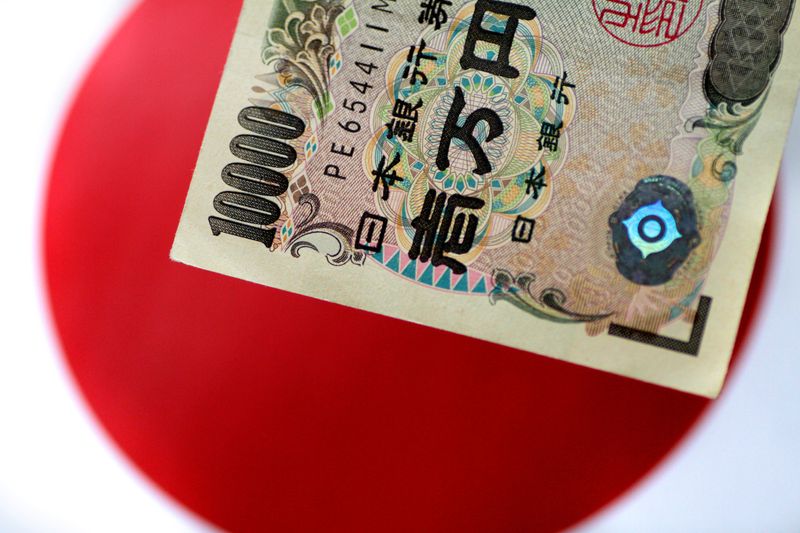Forex
BOJ tweak stirs yen volatility; dollar stays down after US data


© Reuters. FILE PHOTO-A Japan Yen note is seen in this illustration photo taken June 1, 2017. REUTERS/Thomas White/Illustration/File Photo
By Laura Matthews
NEW YORK (Reuters) – The yen had its most volatile trading session in months on Friday after the Bank of Japan tweaked its yield curve control policy, leaving investors wondering if an eventual shift in its massive stimulus program is approaching.
Whipsawing as traders digested the decision, the Japanese yen weakened 1.13% versus the greenback and was last at 141.05 per dollar in the New York afternoon session.
The BOJ is offering to buy 10-year Japanese government bonds (JGB) at 1.0% and is keeping its short-term interest rate at minus 0.1% and the 10-year government bond yield around 0%.
“This is a first step in moving to a tightening in overall monetary policy settings,” said Karl Schamotta, chief market strategist, at Corpay in Toronto.
“It does acknowledge that Japan is gradually escaping its inflation trap, and we are seeing signs that the Bank of Japan is going to pull back on its accommodative monetary policy settings in the months and years ahead.”
Schamotta added that the prospect of an increase in yields in Japan is weighing on global yields by suggesting that Japanese investors might keep more money at home, as opposed to redeploying it into government bond markets overseas.
Meanwhile, the dollar fell against a basket of its major peers as investors largely shrugged off new data showing inflation slowing as they continue to sort through multiple central bank decisions this week to understand the outlook for monetary policy.
U.S. annual inflation in June increased by the smallest amount in more than two years, with underlying price pressures moderating. If the trend continues, it could push the Federal Reserve closer to ending its fastest interest rate hiking cycle since the 1980s.
Inflation slowed considerably in the 12 months to June, with the personal consumption expenditures index advancing 3.0%, the smallest annual gain since March 2021, the Commerce Department said on Friday.
The fell 0.049% to 101.630, while the euro rose 0.42% to $1.1019.
“The focus is back on growth and how much growth the U.S. economy can sustain without inflation ticking higher again,” said Adam Button, chief currency analyst at ForexLive in Toronto.
“There’s a great deal of uncertainty about where inflation will ultimately land and what the Federal Reserve will tolerate. Right now, the market is taking it one data point at a time.”
CENTRAL BANK WEEK
Earlier this week, the Fed and the European Central Bank announced interest-rate hikes, as expected. The ECB raised the possibility of a pause in September as inflation pressures show tentative signs of easing with recession worries mounting.
The Fed left the door open to more rate hikes, though Fed Chair Jerome Powell gave few hints about the September meeting.
The Fed is having to balance its fight against inflation with an economy that is showing signs of slowing, but is still growing faster than expected and with a robust labour market.
Sterling was last trading at $1.2854, up 0.48%.
In cryptocurrencies, bitcoin last rose 0.56% to $29,302.02 while last rose 0.88% to $1,874.59.
========================================================
Currency bid prices at 3:38PM (1938 GMT)
Description RIC Last U.S. Close Pct Change YTD Pct High Bid Low Bid
Previous Change
Session
Dollar index
101.6300 101.6900 -0.05% -1.797% +102.0400 +101.3300
Euro/Dollar
$1.1021 $1.0976 +0.42% +2.87% +$1.1047 +$1.0944
Dollar/Yen
141.0450 139.5000 +1.11% +7.58% +141.1450 +138.0500
Euro/Yen
155.45 153.10 +1.53% +10.80% +155.6000 +151.4300
Dollar/Swiss
0.8692 0.8696 -0.02% -5.98% +0.8736 +0.8662
Sterling/Dollar
$1.2854 $1.2795 +0.47% +6.30% +$1.2886 +$1.2767
Dollar/Canadian
1.3235 1.3225 +0.08% -2.31% +1.3249 +1.3200
Aussie/Dollar
$0.6651 $0.6709 -0.85% -2.41% +$0.6713 +$0.6623
Euro/Swiss
0.9580 0.9539 +0.43% -3.18% +0.9593 +0.9526
Euro/Sterling
0.8572 0.8578 -0.07% -3.08% +0.8589 +0.8550
NZ
Dollar/Dollar $0.6157 $0.6182 -0.40% -3.02% +$0.6193 +$0.6121
Dollar/Norway
10.1920 10.2020 -0.07% +3.88% +10.2330 +10.1470
Euro/Norway
11.2360 11.1772 +0.53% +7.06% +11.2400 +11.1556
Dollar/Sweden
10.5380 10.5107 +0.72% +1.25% +10.5885 +10.4769
Euro/Sweden
11.6139 11.5312 +0.72% +4.16% +11.6237 +11.5295

 Forex3 years ago
Forex3 years agoForex Today: the dollar is gaining strength amid gloomy sentiment at the start of the Fed’s week

 Forex3 years ago
Forex3 years agoUnbiased review of Pocket Option broker

 Forex3 years ago
Forex3 years agoDollar to pound sterling exchange rate today: Pound plummeted to its lowest since 1985

 Forex3 years ago
Forex3 years agoHow is the Australian dollar doing today?

 Cryptocurrency3 years ago
Cryptocurrency3 years agoWhat happened in the crypto market – current events today

 World3 years ago
World3 years agoWhy are modern video games an art form?

 Commodities3 years ago
Commodities3 years agoCopper continues to fall in price on expectations of lower demand in China

 Economy3 years ago
Economy3 years agoCrude oil tankers double in price due to EU anti-Russian sanctions





















